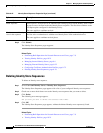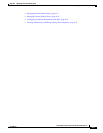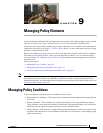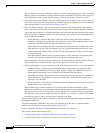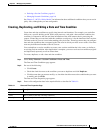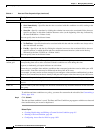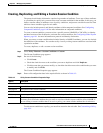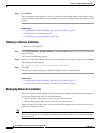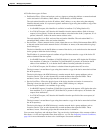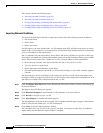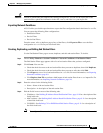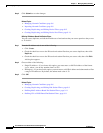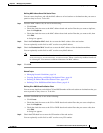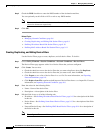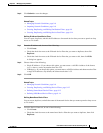
9-6
User Guide for Cisco Secure Access Control System 5.3
OL-24201-01
Chapter 9 Managing Policy Elements
Managing Policy Conditions
Step 4 Click Submit.
The new custom session condition is saved. The Custom Condition page appears with the new custom
session condition. Clients that are associated with this condition are subject to it for the duration of their
session.
Related Topics
• Creating, Duplicating, and Editing a Date and Time Condition, page 9-3
• Deleting a Session Condition, page 9-6
• Configuring Access Service Policies, page 10-21
Deleting a Session Condition
To delete a session condition:
Step 1 Select Policy Elements > Session Conditions > session condition, where session condition is Date and
Time or Custom.
The Session Condition page appears.
Step 2 Check one or more check boxes next to the session conditions that you want to delete and click Delete.
The following message appears:
Are you sure you want to delete the selected item/items?
Step 3 Click OK.
The Session Condition page appears without the deleted custom session conditions.
Related Topics
• Creating, Duplicating, and Editing a Date and Time Condition, page 9-3
• Creating, Duplicating, and Editing a Custom Session Condition, page 9-5
Managing Network Conditions
Filters are reusable network conditions that you create for end stations, network devices, and network
device ports. Filters enable ACS 5.3 to do the following:
• Decide whether or not to grant network access to users and devices.
• Decide on the identity store, service, and so on to be used in policies.
After you create a filter with a name, you can reuse this filter multiple times across various rules and
policies by referring to its name.
Note The filters in ACS 5.3 are similar to the NARs in ACS 4.x. In ACS 4.x, the NARs were based on either
the user or user group. In 5.3, the filters are independent conditions that you can reuse across various
rules and policies.



